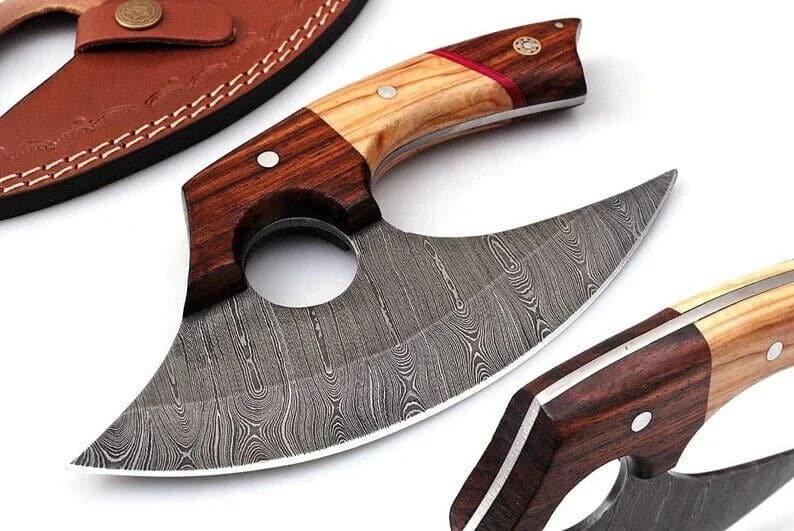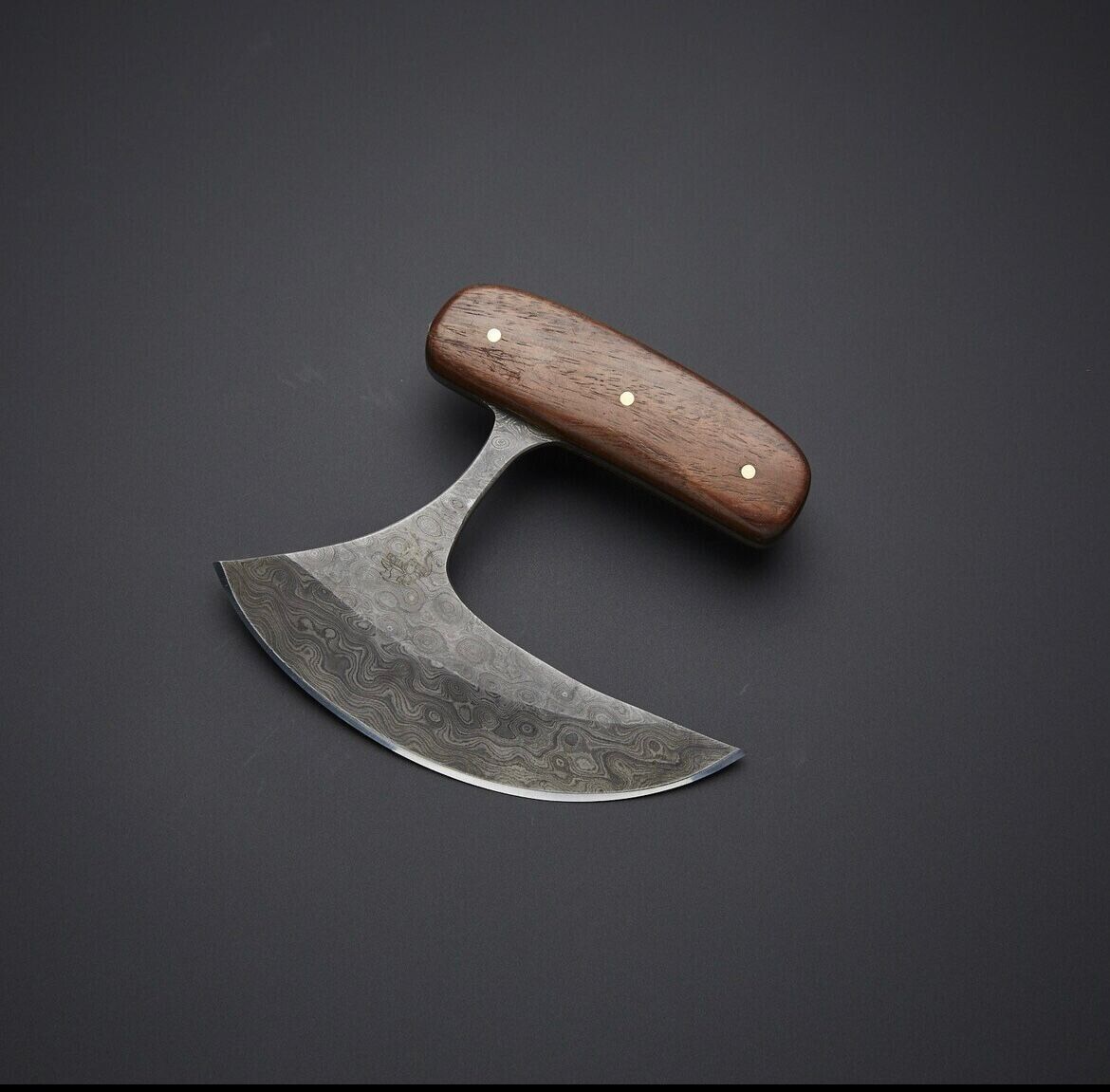Introduction
In the vast world of kitchen cutlery, there exists a tool that embodies both tradition and functionality—the Ulu knife. Originating from the indigenous Inuit people of Alaska, the Ulu knife has transcended its cultural roots to become a versatile and cherished kitchen companion for chefs and home cooks alike. In this exploration, we’ll dive deep into the origins, design, uses, and cultural significance of the Ulu knife, unveiling the secrets behind this unique culinary marvel.
Origins and Cultural Heritage
To truly understand the essence of the Ulu knife, one must journey back to the icy landscapes of Alaska, where the indigenous Inuit people crafted this tool centuries ago. The word “Ulu” itself translates to “woman’s knife” in the Inuit language, reflecting its historical association with the women of the community who skillfully used it for various tasks.
The Ulu knife’s design is distinctive, featuring a semi-circular blade attached to a handle at the center. This design is not just a product of aesthetics but serves a functional purpose. The semi-circular blade allows for efficient rocking and slicing motions, making it an ideal tool for chopping herbs, vegetables, and even meat with precision.
Anatomy of the Ulu Knife
Blade
At the heart of the Ulu knife lies its unique blade. The blade is carefully constructed to keep a sharp edge and is often composed of stainless steel. The knife’s ability to handle a range of cutting techniques is seen by the curvature of the blade. The curvature allows for a rocking action that improves the chopping experience overall, and the sharp edge guarantees clean cuts.
Handle
The handle of the Ulu knife is traditionally made from wood, bone, or antler, offering a comfortable grip for the user. Modern versions, however, may incorporate materials like plastic or metal for increased durability and ease of maintenance. The handle’s central placement allows for a balanced and controlled cutting experience, making it an ergonomic choice for prolonged kitchen use.
Culinary Applications
While the Ulu knife has its roots in the Inuit culture, its popularity has spread far beyond the icy tundra of Alaska. Chefs and home cooks worldwide have embraced the Ulu for its exceptional versatility in the kitchen.
Precision Chopping
The rocking motion facilitated by the Ulu knife’s unique design makes it perfect for precision chopping. Herbs, vegetables, and even fruits yield to its finely tuned blade, allowing the cook to achieve the desired consistency in their ingredients.
Meat Preparation
The Ulu knife’s prowess extends to meat preparation, where its sharp blade effortlessly slices through cuts of meat. Its ergonomic design and efficient cutting motion make it an excellent choice for trimming fat, deboning, and creating thin, uniform slices.
Baking and Dough Work
In the realm of baking, the Ulu knife finds yet another application. Its rocking motion proves invaluable when working with dough, allowing for the efficient cutting and shaping of bread, pastries, and other baked goods.
Cultural Significance
Beyond its utility in the kitchen, the Ulu knife holds a special place in the cultural tapestry of the Inuit people. Traditionally, the knife was passed down through generations, symbolizing not just a culinary tool but a connection to heritage and ancestry. The craftsmanship involved in creating these knives often includes intricate designs and carvings, adding an artistic dimension to their cultural significance.
Modern Interpretations and Innovation
As the Ulu knife continues to captivate culinary enthusiasts, modern interpretations and innovations have emerged. From different materials for the blade and handle to enhanced ergonomic designs, contemporary Ulu knives blend tradition with modernity. Some versions even incorporate folding mechanisms, making them more portable and convenient for on-the-go culinary adventures.
Caring for Your Ulu Knife
To ensure the longevity of your Ulu knife, proper care is essential. Regular sharpening, handwashing, and avoiding exposure to harsh chemicals or extreme temperatures will preserve its sharpness and beauty. Remember, the Ulu knife is not just a kitchen tool; it’s a piece of history and craftsmanship deserving of respect and care.
Recipes and Culinary Adventures with the Ulu
Now that we’ve uncovered the history, design, and cultural significance of the Ulu knife, let’s embark on a culinary journey. What dishes can be elevated by the precise and efficient cuts of the Ulu knife? Let’s explore a few recipes that truly showcase the versatility of this remarkable kitchen tool.
1. Ulu-Chopped Pesto:
Begin by rocking the Ulu knife through fresh basil, garlic, pine nuts, Parmesan cheese, and olive oil. The result? A vibrant and aromatic pesto that pairs perfectly with pasta, sandwiches, or as a delightful topping for grilled meats.
2. Ulu-Sliced Ratatouille:
Channel your inner culinary artist by using the Ulu knife to thinly slice vibrant vegetables like eggplant, zucchini, and bell peppers. Layer them in a baking dish, drizzle with olive oil, and bake until beautifully tender. The Ulu’s precision ensures a visually stunning and deliciously textured dish.
3. Ulu-Diced Salsa:
When it comes to making salsa, the Ulu knife’s rocking motion allows for a quick and uniform dice of tomatoes, onions, jalapeños, and cilantro. Your homemade salsa will have the perfect balance of flavors and textures.
4. Ulu-Prepared Sushi Rolls:
Elevate your sushi-making skills by using the Ulu knife to slice through rolls with finesse. Its sharp blade ensures clean cuts, presenting your homemade sushi with restaurant-quality precision.
Ulu Knife as a Culinary Companion
As we experiment with diverse recipes, it becomes evident that the Ulu knife is not just a kitchen tool; it’s a culinary companion that enhances the joy of cooking. Its unique design allows for a seamless transition between various cutting techniques, empowering chefs to explore their creativity in the kitchen.
Sharing the Ulu Experience
Part of the magic of the Ulu knife lies in its ability to bring people together. Whether you’re passing down a family heirloom or introducing a friend to the joys of Ulu cooking, the experience is a communal one. The Ulu knife is more than just an instrument; it’s a conversation starter, a cultural ambassador that sparks stories and memories.
Ulu Knife in Popular Culture
Beyond its role in the kitchen, the Ulu knife has made its mark in popular culture. From appearances in culinary TV shows to its adoption by renowned chefs, the Ulu has become a symbol of authenticity and a nod to the rich traditions that underpin the culinary world.
Future of the Ulu Knife
As we look ahead, the Ulu knife’s journey continues to unfold. Its timeless design and cultural resonance ensure that it will remain a fixture in kitchens worldwide. Perhaps we’ll witness further innovations, collaborations, and a deeper integration of the Ulu knife into contemporary culinary practices.
In conclusion, the Ulu knife transcends its functional purpose, embodying a connection to history, culture, and the simple joy of preparing and sharing a meal. So, the next time you wield this unique kitchen tool, consider the centuries of tradition and craftsmanship that you hold in your hands. The Ulu knife is not just a slice through ingredients; it’s a slice through time, connecting you to the roots of culinary artistry.
Conclusion
In the realm of kitchen cutlery, the Ulu knife stands as a unique and storied tool, blending tradition, functionality, and cultural significance. From its origins in the frosty landscapes of Alaska to its modern interpretations in kitchens worldwide, the Ulu knife continues to carve its place in culinary history. Embracing the Ulu knife is about more than just improving your cooking abilities, whether you’re a seasoned chef or a novice home cook. It’s about establishing a connection with a rich cultural legacy that spans decades. Thus, the next time you use this culinary wonder, keep in mind that you’re engaging in a long-standing custom rather than just slicing ingredients.



8lrxcr
Equilibrado
Aparatos de calibracion: clave para el desempeno estable y optimo de las dispositivos.
En el campo de la innovacion actual, donde la rendimiento y la estabilidad del equipo son de maxima significancia, los dispositivos de balanceo tienen un funcion esencial. Estos aparatos especificos estan creados para ajustar y fijar piezas rotativas, ya sea en herramientas de fabrica, medios de transporte de traslado o incluso en electrodomesticos domesticos.
Para los expertos en reparacion de sistemas y los tecnicos, trabajar con dispositivos de equilibrado es esencial para garantizar el rendimiento estable y confiable de cualquier aparato giratorio. Gracias a estas alternativas innovadoras modernas, es posible minimizar considerablemente las oscilaciones, el zumbido y la esfuerzo sobre los cojinetes, mejorando la longevidad de partes importantes.
Tambien trascendental es el funcion que juegan los equipos de calibracion en la soporte al comprador. El asistencia especializado y el reparacion constante usando estos equipos permiten ofrecer soluciones de excelente nivel, mejorando la satisfaccion de los clientes.
Para los responsables de proyectos, la aporte en unidades de balanceo y medidores puede ser importante para aumentar la eficiencia y eficiencia de sus aparatos. Esto es principalmente trascendental para los emprendedores que dirigen modestas y intermedias empresas, donde cada aspecto cuenta.
Asimismo, los aparatos de ajuste tienen una amplia implementacion en el ambito de la prevencion y el gestion de nivel. Posibilitan detectar eventuales problemas, reduciendo mantenimientos caras y averias a los equipos. Mas aun, los informacion extraidos de estos dispositivos pueden utilizarse para mejorar procesos y incrementar la reconocimiento en motores de investigacion.
Las areas de aplicacion de los aparatos de balanceo comprenden numerosas areas, desde la fabricacion de ciclos hasta el control ambiental. No importa si se trata de extensas producciones productivas o limitados espacios domesticos, los aparatos de equilibrado son fundamentales para proteger un funcionamiento productivo y sin presencia de interrupciones.